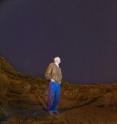Asteroid monitored from outer space to ground impact
Reports by scientists of meteorites striking Earth in the past have resembled police reports of so many muggings — the offenders came out of nowhere and then disappeared into the crowd, making it difficult to get more than very basic facts. Now an international research team has been able to identify an asteroid in space before it entered Earth's atmosphere, enabling computers to determine its area of origin in the solar system as well as predict the arrival time and location on Earth of its shattered surviving parts.
"I would say that this work demonstrates, for the first time, the ability of astronomers to discover and predict the impact of a space object," says Sandia National Laboratories researcher Mark Boslough, a member of the research team.
Perhaps more importantly, the event tested the ability of society to respond very quickly to a predicted impact, says Boslough. "In this case, it was never a threat, so the response was scientific. Had it been deemed a threat — a larger asteroid that would explode over a populated area — an alert could have been issued in time that could potentially save lives by evacuating the danger zone or instructing people to take cover."
The profusion of information in this case also helps meteoriticists learn the orbits of parent bodies that yield various types of meteorites.
Such knowledge could help future space missions explore or even mine the asteroids in Earth-crossing orbits, Boslough says.
The four-meter-diameter asteroid, called 2008 TC3, was initially sighted by the automated Catalina Sky Survey telescope at Mount Lemmon, Ariz., on Oct. 6. Numerous observatories, alerted to the invader, then imaged the object. Computations correctly predicted impact would occur 19 hours after discovery in the Nubian Desert of northern Sudan.
According to NASA's Near Earth Object program, "A spectacular fireball lit up the predawn sky above Northern Sudan on October 7, 2008."
A wide variety of analyses were performed while the asteroid was en route and after its surviving pieces were located by meteorite hunters in an intense search.
Researchers, listed in the paper describing this work in the March 26 issue of the journal Nature, range from the SETI Institute, the University of Khartoum, Juba University (Sudan), Sandia, Caltech, NASA Johnson Space Center and NASA Ames, to other universities in the U.S., Canada, Ireland, England, Czech Republic and the Netherlands.
Sandia researcher Dick Spalding interpreted recorded data about the atmospheric fireball, and Boslough estimated the aerodynamic pressure and strength of the asteroid based on the estimated burst altitude of 36 kilometers.
Searchers have recovered 47 meteorites so far — offshoots from the disintegrating asteroid, mostly immolated by its encounter with atmospheric friction — with a total mass of 3.95 kilograms.
The analyzed material showed carbon-rich materials not yet represented in meteorite collections, indicating that fragile materials still unknown may account for some asteroid classes. Such meteorites are less likely to survive due to destruction upon entry and weathering once they land on Earth's surface.
"Chunks of iron and hard rock last longer and are easier to find than clumps of soft carbonaceous materials," says Boslough.
"We knew that locating an incoming object while still in space could be done, but it had never actually been demonstrated until now," says Boslough. "In this post-rational age where scientific explanations and computer models are often derided as 'only theories,' it is nice to have a demonstration like this."
Source: DOE/Sandia National Laboratories
Articles on the same topic
- UK astronomers observe asteroid before it crashes into EarthThu, 26 Mar 2009, 13:26:38 UTC
- Asteroid impact helps trace meteorite originsWed, 25 Mar 2009, 18:22:30 UTC
Other sources
- UK astronomers observe asteroid before it crashes into Earthfrom Science BlogThu, 26 Mar 2009, 15:53:51 UTC
- Meteorites in Africa Traced to Asteroid "Parent"from National GeographicThu, 26 Mar 2009, 15:28:46 UTC
- Surprise Recovery of Meteorites Following Asteroid Impactfrom Space.comThu, 26 Mar 2009, 15:07:24 UTC
- Astronomers Observe Asteroid Before It Crashes Into Earthfrom Science DailyThu, 26 Mar 2009, 13:21:42 UTC
- Scientists watch asteroid hit atmospherefrom UPIThu, 26 Mar 2009, 3:49:04 UTC
- Asteroid Impact Helps Trace Meteorite Originsfrom Science DailyThu, 26 Mar 2009, 3:35:08 UTC
- Tracked asteroid debris collectedfrom BBC News: Science & NatureThu, 26 Mar 2009, 2:35:14 UTC
- Rock Science: First Meteorites Recovered on Earth from an Asteroid Tracked in Spacefrom Scientific AmericanWed, 25 Mar 2009, 23:49:13 UTC
- We Saw It Coming: Asteroid Monitored from Outer Space to Ground Impactfrom Newswise - ScinewsWed, 25 Mar 2009, 21:21:06 UTC
- Asteroid tracked from space to Earth for 1st timefrom CBC: Technology & ScienceWed, 25 Mar 2009, 19:43:12 UTC
- Asteroid Impact Helps Trace Meteorite Originsfrom PhysorgWed, 25 Mar 2009, 19:14:57 UTC
- Scientists Examine Asteroid Remainsfrom NY Times ScienceWed, 25 Mar 2009, 19:00:13 UTC
- Space 'Rosetta Stone' Unlike Anything Seen Beforefrom Live ScienceWed, 25 Mar 2009, 18:43:14 UTC
- Space 'Rosetta Stone' Unlike Anything Seen Beforefrom Space.comWed, 25 Mar 2009, 18:42:32 UTC
- Asteroid tracked from space to Earthfrom Sciencenews.orgWed, 25 Mar 2009, 18:15:32 UTC
- 80-ton asteroid's impact recordedfrom BBC News: Science & NatureWed, 25 Mar 2009, 18:14:14 UTC

